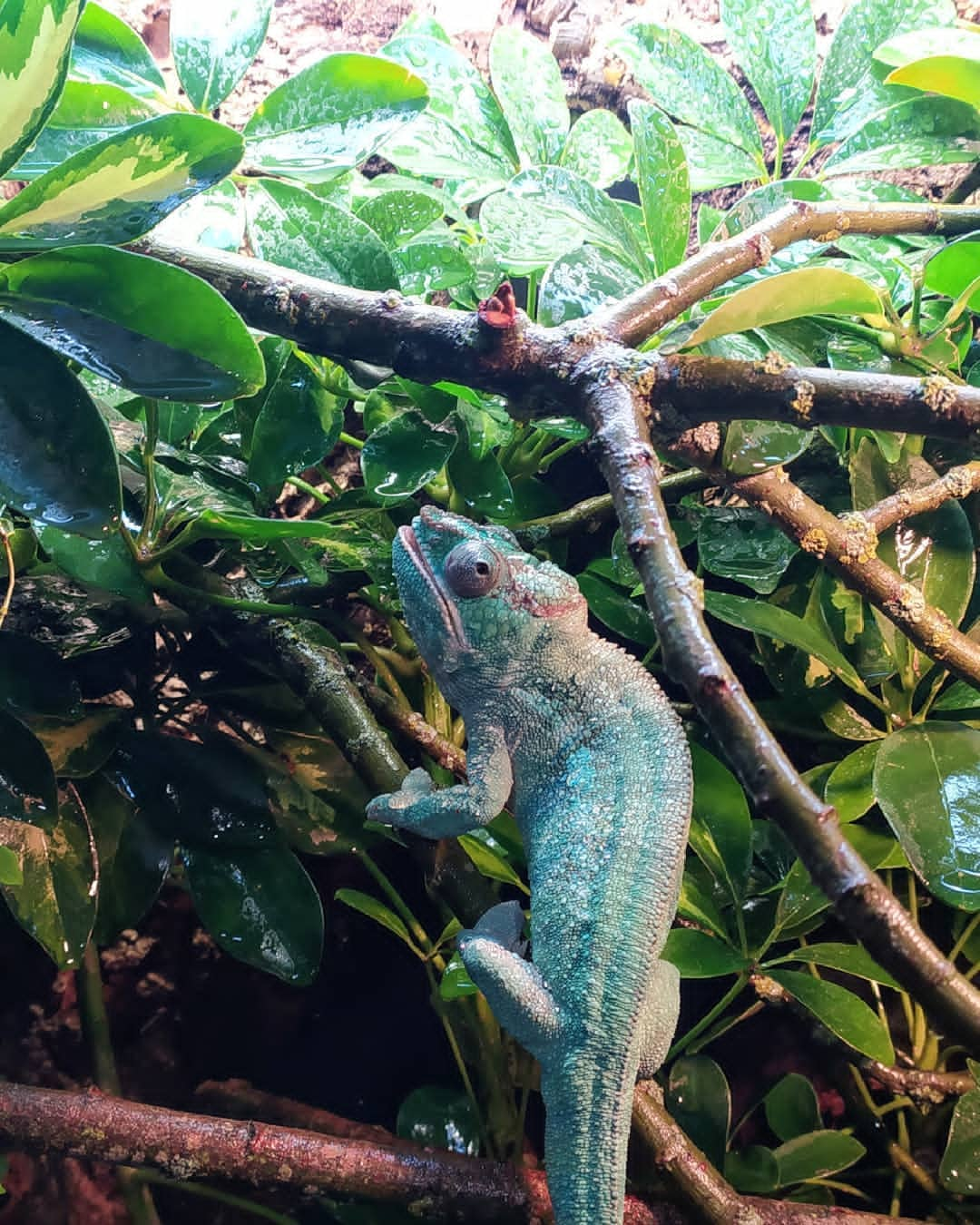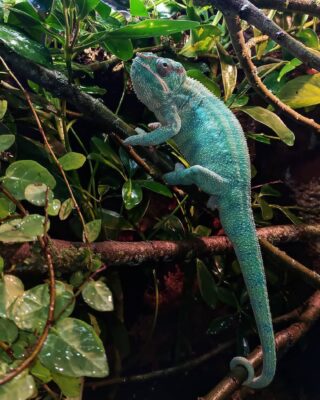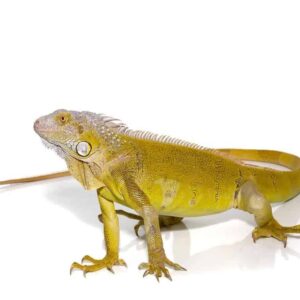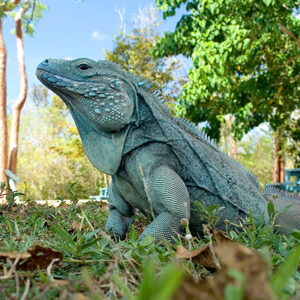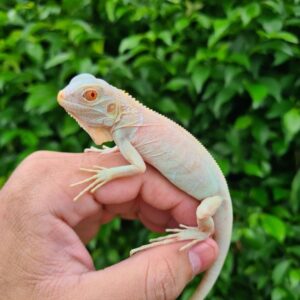Ambilobe Panther Chameleon For Sale
$250.00
Ambilobe Panther Chameleon
Ambilobe panther chameleon (Furcifer pardalis) is a subspecies of panther chameleons that are found in the northern and eastern parts of Madagascar in the rainforest biome that is tropical. In addition, it has recently been brought to Reunion in Reunion and Mauritius.
The Ambilobe Panther Chameleon for auction can be the largest and most well-known subspecies of panther, the reason being that it comes with exceptional colors, as well as a variety of these colors too.
Description
The Ambilobe Panther Chameleon, scientifically known as Furcifer pardalis, is a captivating reptile native to the tropical regions of Madagascar. Renowned for its vibrant coloration and mesmerizing patterns, this species is a standout in the world of herpetology. The Ambilobe Panther Chameleon has garnered substantial interest and admiration among reptile enthusiasts, not only for its striking appearance but also for its fascinating behaviors and adaptability in diverse environments.
Distinguished by its vivid hues of green, blue, red, and yellow, the Ambilobe Panther Chameleon is often considered one of the most beautiful chameleon species. The males, in particular, exhibit an extraordinary range of colors, which they use for communication and mating displays. Females, while less flamboyant, possess their own subtle charm with softer coloration. This dimorphism between the sexes adds another layer of intrigue to this species.
In addition to their aesthetic appeal, Ambilobe Panther Chameleons exhibit remarkable physiological adaptations. Their independently moving eyes allow them to have a 360-degree view of their surroundings, making them highly effective hunters. Their specialized feet and prehensile tails enable them to navigate their arboreal habitats with ease, while their long, sticky tongues can capture prey with pinpoint accuracy.
The popularity of the Ambilobe Panther Chameleon among reptile enthusiasts is also due to its relatively manageable care requirements compared to other exotic reptiles. With proper habitat setup, including adequate humidity, temperature, and a diet of live insects, these chameleons can thrive in captivity. Their engaging behaviors and the challenge they present to keepers make them a rewarding species for dedicated hobbyists.
Overall, the Ambilobe Panther Chameleon stands out as a remarkable example of nature’s artistry and adaptability. Its unique characteristics make it a subject of fascination and study, contributing significantly to our understanding of reptilian biodiversity and ecology.
Habitat and Natural Environment
The Ambilobe Panther Chameleon, scientifically known as Furcifer pardalis, is endemic to Madagascar, an island nation renowned for its rich biodiversity. This species primarily inhabits the northwestern regions of the island, particularly around the Ambilobe area from which it derives its name. The chameleon’s natural habitat is typically characterized by tropical and subtropical forests, where the climate is warm and humid, creating an ideal environment for its survival.
The climate in this region of Madagascar is predominantly tropical, with distinct wet and dry seasons. The wet season, spanning from November to April, is marked by heavy rainfall and high humidity levels, which contribute to the lush vegetation that these chameleons depend on. Conversely, the dry season, extending from May to October, offers a more arid environment but still maintains sufficient humidity for the chameleons to thrive. This cyclical pattern of precipitation plays a crucial role in shaping the Ambilobe Panther Chameleon’s behavior and reproductive cycles.
Vegetation in the Ambilobe region is dense and diverse, comprising a mix of tropical rainforests, deciduous forests, and secondary growth forests. These environments provide ample foliage and a variety of perches, which are essential for the chameleons’ arboreal lifestyle. The diverse plant life supports a rich insect population, forming the primary diet of the Ambilobe Panther Chameleon. This abundance of prey is vital for their nutritional needs and overall wellbeing.
The intricate interplay between the climate, vegetation, and other environmental factors profoundly influences the Ambilobe Panther Chameleon’s daily behavior. For instance, their coloration, which is often used for communication and camouflage, can vary significantly based on their immediate surroundings and mood. Additionally, the availability of food sources during different seasons can affect their foraging habits and territorial behaviors. Understanding these environmental conditions is crucial for appreciating the natural lifestyle and ecological significance of the Ambilobe Panther Chameleon.
Physical Characteristics and Coloration
The Ambilobe Panther Chameleon (Furcifer pardalis) is renowned for its striking physical characteristics and vibrant coloration. These chameleons typically measure between 14 to 21 inches in length, with males generally being larger than females. Their body structure is adapted for an arboreal lifestyle, featuring a laterally compressed body, prehensile tail, and zygodactylous feet. The prehensile tail acts as a fifth limb, providing stability and support when navigating through trees, while the zygodactylous feet—two toes facing forward and two backward—offer a firm grip on branches.
One of the most captivating aspects of the Ambilobe Panther Chameleon is its coloration. Males exhibit a dazzling array of colors, including bright shades of red, blue, green, and yellow. These colors are not just for show; they play a crucial role in communication and camouflage. The chameleon’s ability to change color is influenced by several factors such as mood, health, and environmental conditions. For instance, a male chameleon might display more vibrant colors when courting a female or when feeling threatened.
In contrast, female Ambilobe Panther Chameleons tend to be more subdued in their coloration, usually displaying hues of brown, gray, or pale green. This difference in appearance serves a protective function, making females less conspicuous to predators, especially when they are gravid (carrying eggs). The differences in coloration between males and females also facilitate easier identification and mating in their natural habitat.
The pigment cells in their skin, known as chromatophores, contain various pigments that expand or contract to produce a wide range of colors. Additionally, specialized cells called iridophores reflect light and add to the chameleon’s color palette. This complex interaction of pigments and light reflection allows the Ambilobe Panther Chameleon to exhibit its signature, breathtaking hues.
Diet and Feeding Habits
The Ambilobe Panther Chameleon, a striking reptile known for its vibrant colors, has a diet that primarily consists of live insects. In the wild, these chameleons demonstrate a preference for a variety of prey, including crickets, roaches, and worms. This diverse diet not only satisfies their nutritional needs but also supports their natural hunting instincts. Captive chameleons, however, require a more controlled feeding regimen to ensure they receive all necessary nutrients.
One of the most crucial aspects of feeding Ambilobe Panther Chameleons in captivity is the practice of gut-loading. This involves feeding the insects a nutritious diet before offering them to the chameleon. Gut-loading ensures that the prey insects are rich in essential vitamins and minerals, which are then passed on to the chameleon. Common gut-loading foods for insects include leafy greens, carrots, and commercial gut-load products specifically designed for feeder insects.
In addition to gut-loading, supplementation plays a vital role in maintaining the health of Ambilobe Panther Chameleons. Dusting the feeder insects with calcium and vitamin powders helps prevent common deficiencies. Calcium is particularly important for bone health, while vitamins such as D3 aid in calcium absorption. It is recommended to dust insects with calcium at every feeding and with a multivitamin supplement once or twice a week.
When it comes to feeding practices, frequency and portion sizes are key considerations. Juvenile chameleons require daily feedings to support their rapid growth, typically consuming 10-15 appropriately sized insects per day. Adult chameleons, on the other hand, can be fed every other day, with a portion size of 5-10 insects per feeding. It is important to observe each chameleon’s appetite and adjust portions accordingly to prevent overfeeding or underfeeding.
Providing a varied diet, practicing gut-loading, and ensuring appropriate supplementation are essential to the well-being of Ambilobe Panther Chameleons. By adhering to these feeding practices, owners can help their chameleons thrive in captivity, reflecting the vibrant health and colors these remarkable reptiles are known for.
Behavior and Social Interaction
The Ambilobe Panther Chameleon exhibits a fascinating array of behaviors that highlight its unique adaptation to its environment. Known for their territorial nature, these chameleons are solitary creatures that prefer to live alone. Males, in particular, are highly territorial and will aggressively defend their space from intruders. This territoriality is often established and maintained through a series of visual displays and physical posturing.
One of the most striking aspects of the Ambilobe Panther Chameleon’s behavior is its ability to change color. This color-changing ability is not just for camouflage but serves as a critical means of communication. Males use vibrant color changes to assert dominance, display aggression, or attract potential mates. When a male encounters a rival, it may exhibit bright, bold colors to signal its readiness to defend its territory. Conversely, a submissive chameleon might display duller colors to avoid confrontation.
In addition to color changes, body language plays a significant role in their communication. Posturing, such as puffing up the body, flattening the body sideways, and head bobbing, are common behaviors used to convey messages to other chameleons. These physical displays are often accompanied by hissing or other vocalizations to further emphasize the chameleon’s intent.
When it comes to their interaction with humans, Ambilobe Panther Chameleons can be quite intriguing pets. However, it is important to remember that they are naturally solitary animals and can become stressed if handled excessively. They generally prefer minimal human interaction and thrive best in environments that closely mimic their natural habitat. Providing ample space, proper foliage, and maintaining optimal temperature and humidity levels are crucial for their well-being.
Understanding the behavior and social interaction of the Ambilobe Panther Chameleon is essential for anyone considering keeping one as a pet. By respecting their natural instincts and behaviors, owners can create a more harmonious and enriching environment for these captivating creatures.
Reproduction and Lifespan
The Ambilobe Panther Chameleon, a strikingly colorful reptile native to Madagascar, undergoes a fascinating reproductive cycle. The courtship rituals of this species are quite elaborate, often involving vibrant color displays by males to attract potential mates. These displays are not only a means to impress females but also serve as a deterrent to rival males. Once a female is receptive, the mating process takes place, usually during the warmer months when conditions are optimal for reproduction.
Following successful mating, the female Ambilobe Panther Chameleon embarks on the crucial task of egg-laying. She will seek out a suitable nesting site, often a soft, sandy substrate where she can dig a burrow to deposit her eggs. This nesting site needs specific conditions to ensure the eggs’ viability, including appropriate temperature and humidity levels. In captivity, breeders must replicate these conditions by providing a substrate that mimics the chameleon’s natural habitat, along with careful monitoring of environmental factors.
After laying the eggs, the female covers them with soil, and the incubation period begins. The eggs typically require several months to hatch, with the exact duration heavily influenced by temperature and humidity. Maintaining consistent conditions during this period is critical for successful hatching. Once the eggs hatch, the tiny chameleons emerge, ready to begin their independent lives.
The lifespan of the Ambilobe Panther Chameleon varies depending on whether they are in the wild or captivity. In their natural habitat, they generally live for about 2 to 3 years, with various environmental factors such as predation and disease influencing their longevity. In captivity, however, with proper care and optimal conditions, these chameleons can live significantly longer, often reaching 5 to 7 years. Factors such as diet, habitat quality, and stress levels play crucial roles in determining their overall lifespan.
Understanding the reproductive cycle and lifespan of the Ambilobe Panther Chameleon is essential for enthusiasts and breeders alike, ensuring these captivating creatures can thrive both in the wild and under human care.
Housing and Care in Captivity
Creating an optimal environment for the Ambilobe Panther Chameleon requires careful consideration of various factors, ensuring the health and well-being of this captivating species. First and foremost, selecting an appropriately sized enclosure is crucial. For adult chameleons, a vertical cage measuring at least 24 x 24 x 48 inches is recommended, providing ample space for climbing and exploration. Mesh enclosures are preferred over glass, as they ensure better ventilation and reduce the risk of respiratory issues.
Proper lighting is essential for the Ambilobe Panther Chameleon. A combination of UVB and basking lights should be used. UVB lighting is vital for calcium absorption and preventing metabolic bone disease, while a basking light helps maintain the necessary temperature gradient within the enclosure. The basking spot should be maintained at 85-90°F, with the ambient temperature ranging between 70-80°F. Nighttime temperatures can safely drop to around 65-70°F.
Humidity levels should be carefully monitored, as they play a significant role in the chameleon’s health. Aim for a humidity range of 50-70%. This can be achieved by misting the enclosure several times a day or using an automated misting system. A hygrometer can help in keeping track of humidity levels. Additionally, live plants such as pothos, ficus, or schefflera can aid in maintaining humidity and provide enrichment.
The choice of substrate is another important aspect. While some keepers prefer using paper towels or reptile carpet for ease of cleaning, others opt for naturalistic setups with coconut fiber or organic soil. Whichever substrate is chosen, it should be kept clean and dry to prevent bacterial growth and health issues.
Enrichment is essential for the mental and physical well-being of the Ambilobe Panther Chameleon. Incorporate a variety of branches, vines, and plants to mimic their natural habitat. This not only provides climbing opportunities but also helps reduce stress. Regular maintenance includes spot cleaning daily, thorough cleaning of the enclosure bi-weekly, and regular health checks for signs of illness or stress.
By paying attention to these factors, you can create a thriving environment for your Ambilobe Panther Chameleon, ensuring it leads a healthy and enriched life in captivity.
Common Health Issues and Solutions
Ambilobe Panther Chameleons, like many reptiles, can be prone to a variety of health issues if their care requirements are not meticulously met. One of the most prevalent conditions is metabolic bone disease (MBD), which is often due to inadequate calcium intake or insufficient UVB lighting. Symptoms of MBD include lethargy, soft or swollen limbs, and difficulty moving. To prevent this condition, ensure that your chameleon has access to a balanced diet rich in calcium, and provide appropriate UVB lighting.
Respiratory infections are another common ailment, typically caused by improper humidity levels or poor ventilation in the enclosure. Signs of respiratory infections include wheezing, open-mouth breathing, and nasal discharge. Maintaining the right humidity levels and ensuring good air circulation can significantly reduce the risk. If symptoms appear, seek veterinary care promptly—early intervention can prevent the infection from becoming severe.
Parasites, both internal and external, also pose a threat to Ambilobe Panther Chameleons. Regular fecal examinations by a veterinarian can help detect internal parasites, while a close inspection of the chameleon’s skin can reveal external parasites like mites. Symptoms of parasitic infections include weight loss, abnormal feces, and changes in behavior. Treatment typically involves antiparasitic medications prescribed by a vet.
Preventive care is crucial for maintaining the overall health and wellness of Ambilobe Panther Chameleons. Regular veterinary check-ups, a well-balanced diet, and optimal living conditions are key. Additionally, it is essential to monitor your chameleon’s behavior and physical condition regularly to detect any early signs of health issues. Promptly addressing these symptoms with professional veterinary care can mitigate health risks and ensure a long, healthy life for your reptile companion.


